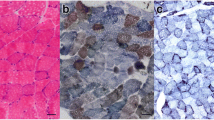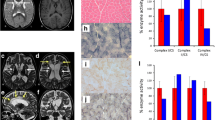Abstract
We report on the clinical, molecular and biochemical findings of a patient with the rare event (<4.02 × 10−9 per generation) of coinciding de novo mutations in the nuclear PAX6 (c.1252–1267del16) and the mitochondrial mt.RNA Lys (8347A→G) genes. The boy suffers from exercise intolerance, ptosis, nystagmus, macular hypoplasia and anterior segment abnormalities evocative of Axenfeld–Rieger anomaly. The PAX6 mutation is predicted to cause haploinsufficiency. The novel mt.RNA Lys mutation is located close to the classic myoclonic epilepsy with ragged-red-fibers mutation, but the patient exhibits neither myoclonic epilepsy nor ragged-red-fibers. The degree of mutant mtDNA heteroplasmy, as determined by a very accurate pyrosequencing assay, varies between 31% (muscle) and 38% (fibroblasts). We discuss a potential effect of the PAX6 mutation on the mtDNA mutation rate.


Similar content being viewed by others

References
Glaser T, Walton DS, Maas RL (1992) Genomic structure, evolutionary conservation and aniridia mutation in the human PAX6 gene. Nat Genet 2:232–239
Sisodiya SM, Free SL, Williamson KA, Mitchell TN, Willis C, Stevens JM, Kendall BE, Shorvon SD, Hanson IM, Moore AT, van Heyningen V (2001) PAX6 haploinsufficiency causes cerebral malformations and olfactory dysfunction in humans. Nat Genet 28:214–216
Hensey C, Gautier J (1998) Programmed cell death during Xenopus development: a spatio-temporal analysis. Dev Biol 203:36–48
Brandon MC, Lott MT, Nguyen KC, Spolim S, Navathe SB, Baldi P, Wallace DC (2005) MITOMAP: a human mitochondrial genome database—2004 update. Nucleic Acids Res 33:D611–D613
DiMauro S, Schon EA (2001) Mitochondrial DNA mutation in human disease. Am J Med Genet 106:18–26
Schuelke M, Krude H, Finckh B, Mayatepek E, Janssen A, Schmelz M, Trefz F, Trijbels F, Smeitink J (2002) Septo-optic dysplasia associated with a new mitochondrial cytochrome b mutation. Ann Neurol 51:388–392
Wong LJ, Lam CW (1997) Alternative, noninvasive tissues for quantitative screening of mutant mitochondrial DNA. Clin Chem 43:1241–1243
Ernst BP, Wilichowski E, Wagner M, Hanefeld F (1994) Deletion screening of mitochondrial DNA via multiprimer DNA amplification. Mol Cell Probes 8:45–49
Morrison D, FitzPatrick D, Hanson I, Williamson K, van Heyningen V, Fleck B, Jones I, Chalmers J, Campbell H (2002) National study of microphthalmia, anophthalmia, and coloboma (MAC) in Scotland: investigation of genetic aetiology. J Med Genet 39:16–22
van Heyningen V, Williamson KA (2002) PAX6 in sensory development. Hum Mol Genet 11:1161–1167
Tzoulaki I, White IMS, Hanson IM (2005) PAX6 mutation: genotype–phenotype correlations. BMC Genet 6:27
Malandrini A, Mari F, Palmeri S, Gambelli S, Berti G, Bruttini M, Bardelli AM, Williamson K, van Heyningen V, Renieri A (2001) PAX6 mutation in a family with aniridia, congenital ptosis, and mental retardation. Clin Genet 60:151–154
Uhlmann K, Brinckmann A, Toliat MR, Ritter H, Nürnberg P (2002) Evaluation of a potential epigenetic biomarker by quantitative methyl–single nucleotide polymorphism analysis. Electrophoresis 23:4072–4079
Yasukawa T, Suzuki T, Ishii N, Ohta S, Watanabe K (2001) Wobble modification defect in tRNA disturbs codon–anticodon interaction in a mitochondrial disease. EMBO J 20:4794–4802
Corona P, Lamantea E, Greco M, Carrara F, Agostino A, Guidetti D, Dotti MT, Mariotti C, Zeviani M (2001) Novel heteroplasmic mtDNA mutation in a family with heterogeneous clinical presentation. Ann Neurol 51:122–188
Spencer HG (2001) Mutation-selection balance. Encyclopedia of Life Sciences, Nature Publishing Group, pp 1–5
Santos C, Montiel R, Sierra B, Bettencourt C, Fernandez E, Alvarez L, Lima M, Abade A, Aluja MP (2005) Understanding differences between phylogenetic and pedigree-derived mtDNA mutation rate: a model using families from the Azores Islands (Portugal). Mol Biol Evol 22:1490–1505
Levitt NC, Hickson ID (2002) Caretaker tumour suppressor genes that defend genome integrity. Trends Mol Med 8:179–186
Krempler F, Esterbauer H, Weitgasser R, Ebenbichler C, Patsch JR, Miller K, Xie M, Linnemayr V, Oberkofler H, Patsch W (2002) A functional polymorphism in the promoter of UCP2 enhances obesity risk but reduces type 2 diabetes risk in obese middle-aged humans. Diabetes 51:3331–3335
Arsenijevic E, Onuma H, Pecqueur C, Raimbault S, Manning BS, Miroux B, Couplan E, Alves-Guerra MC, Goubern M, Surwit R, Bouillaud F, Richard D, Collins S, Ricquier D (2000) Disruption of the uncoupling protein-2 gene in mice reveals a role in immunity and reactive oxygen species production. Nat Genet 26:435–439
Wei YH, Lee HC (2002) Oxidative stress, mitochondrial DNA mutation and impairment of antioxidant enzymes in aging. Exp Biol Med 227:671–682
Human PAX6 Allelic Variant Database. http://www.pax6.hgu.mrc.ac.uk
MITOMAP. http://www.mitomap.org
Revised Cambridge Reference Sequence. http://www.mitomap.org/mitomap_rCRS.gb.txt
Acknowledgments
The authors thank the patient and his family for their participation in this study, Jan Jaroszewski, Anke Horn and Angelika Zwirner for expert clinical and technical assistance and Veronica van Heyningen, David FitzPatrick and Christine Gerstenfeld for critical discussions and valuable suggestions. This study was supported by the Deutsche Forschungsgemeinschaft (Grant SFB 577 TP B3 “Genetic variability of mitochondrial disorders” to MS) and the German Federal Ministry of Science and Education through the National Genome Research Network (Grant# 01GR0416 to P.N.).
Author information
Authors and Affiliations
Corresponding author
Rights and permissions
About this article
Cite this article
Brinckmann, A., Rüther, K., Williamson, K. et al. De novo double mutation in PAX6 and mtDNA tRNA Lys associated with atypical aniridia and mitochondrial disease. J Mol Med 85, 163–168 (2007). https://doi.org/10.1007/s00109-006-0112-y
Received:
Accepted:
Published:
Issue Date:
DOI: https://doi.org/10.1007/s00109-006-0112-y



